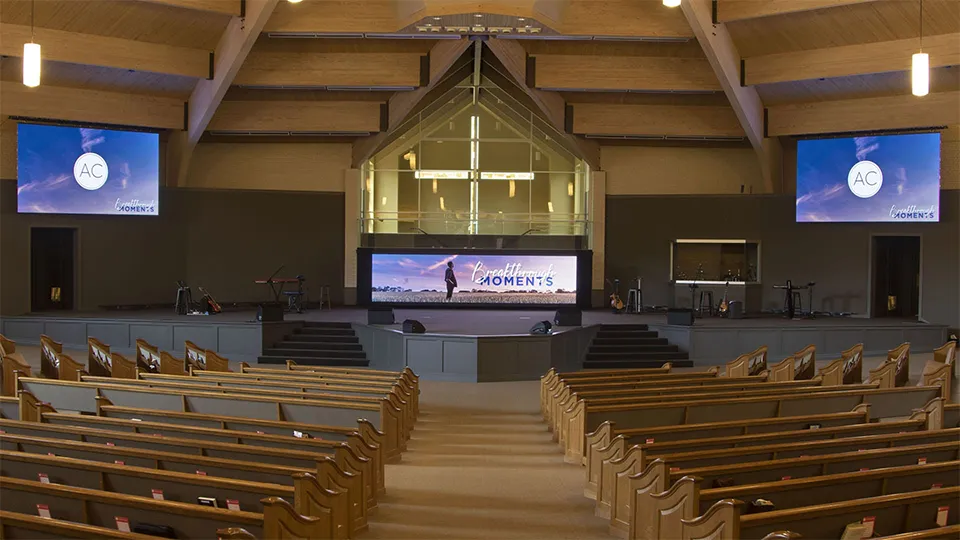
How to choose the right church LED display?
Introduction:
LED screens have proven to be one of the most cost-effective and practical solutions, providing audiences with a stunning visual experience. Nowadays, LED screens are also widely used in churches. They help churches conveniently share information, news, announcements, lyrics, sermon topics, and other presentations with all members.

What Are the Characteristics of Suitable Church LED Display?
Churches are known to be solemn and sacred places, and you certainly want everything to be orderly. LED screens are adaptable and easy-to-operate visual technology that can make your production team’s work easier. Additionally, they can enhance the overall appearance of your venue.
Due to the flexibility and adaptability of LED screens in churches, you can arrange your visual presentations daily or weekly. You can seamlessly splice your LED screens into one large screen, mount them on the central area wall, or scatter them around the church. The excellent brightness of LED screens ensures clear visibility even in well-lit churches.
This is just one of the many reasons LED screens are suitable for churches. It’s easy to say that LED screens are beneficial in churches because they help create a better worship experience than ever before. However, choosing the specific type of LED screen to decorate your church is up to you, and it can be quite challenging.

Factors to Consider When Choosing a Church LED Display
Factor 1: Installation Environment of Church LED Screens
The environment of the church is one of the critical factors to consider. Is it an enclosed area or an open space? Will the location where you plan to place the LED screen be affected by moisture? For instance, if you want to install the LED screen outdoors, you need to look for an outdoor LED screen with a high waterproof rating. Otherwise, your LED screen won’t last long.
Factor 2: Space Reserved for the LED Screen
You also need to consider the structural design of the church and whether the size of the LED screen you choose is suitable for the available space. A small screen in a large space or a large screen in a small space is not ideal. Therefore, before deciding to install an LED screen in your church, you need to carefully measure the space size.
For churches accommodating hundreds or even thousands of believers, a large LED background wall is essential. The larger space also necessitates LED screens with larger spacing to account for the viewing experience of the furthest audience. Conversely, smaller churches are more suitable for LED screens with smaller pixel spacing.
Factor 3: Content to be Displayed on the LED Screen
Installing LED screens in churches aims to attract the congregation’s attention as these displays can enhance interaction and expand the impact of your message. Before finalizing the purchase of an LED screen for your church, have you considered the content you want to display? This is crucial. Do you primarily want to display textual information, or do you plan to showcase dynamic high-definition audio-visual content? Regardless, the LED screen you choose should have a high resolution to display better-quality images.
To achieve a more visually appealing and dynamic presentation experience in your church, we recommend choosing fine pitch LED screens, such as screens with 16:9 or 4:3 ratios. If you are considering a large screen with high-definition display capabilities, we also recommend this HD indoor fixed LED screen: W3. It is an excellent product for indoor viewing.

Factor 4: Choosing the Pixel Pitch of Church LED Screens
Understanding the viewing distance between the audience and the LED screen is crucial as it determines the appropriate pixel pitch of the display. Pixel pitch essentially refers to the density of pixels on an LED screen, and the lower the pixel pitch, the higher the resolution. However, choosing the lowest possible pixel pitch isn’t always the best; it must be considered in the context of actual circumstances.
For audiences close to the church screen, a lower pixel pitch is a better choice to ensure clear images without pixelation. Knowing the viewing distance is essential not only for achieving the best viewing quality but also for budgeting. LED screens with lower pixel pitch are more expensive due to the higher number of LEDs. Therefore, evaluating viewing distance is crucial in cost management and project planning.

Summary
When choosing LED screens for your church, four key factors need to be considered. Your supplier may ask the same questions to determine the best solution to meet your needs.
-
Installation Environment: This refers to installation requirements, including the physical conditions and limitations of the screen placement location.
-
Church Space: This involves the size of the area where the screen will be installed, affecting the size of the LED screen you choose.
-
Display Content: This includes the type of visual effects you intend to project, whether text, images, videos, or a combination. This factor influences the screen’s resolution and technical capabilities.
-
Viewing Distance: It involves understanding the distance between the screen and the congregation, which is crucial for determining the pixel pitch of the screen to ensure clarity and visibility.